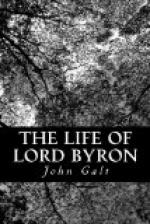His brother, the grandfather of the poet, was the celebrated “Hardy Byron”; or, as the sailors called him, “Foulweather Jack,” whose adventures and services are too well known to require any notice here. He married the daughter of John Trevannion, Esq., of Carhais, in the county of Cornwall, by whom he had two sons and three daughters. John, the eldest, and the father of the poet, was born in 1751, educated at Westminster School, and afterwards placed in the Guards, where his conduct became so irregular and profligate that his father, the admiral, though a good-natured man, discarded him long before his death. In 1778 he acquired extraordinary eclat by the seduction of the Marchioness of Caermarthen, under circumstances which have few parallels in the licentiousness of fashionable life. The meanness with which he obliged his wretched victim to supply him with money would have been disgraceful to the basest adulteries of the cellar or garret. A divorce ensued, the guilty parties married; but, within two years after, such was the brutal and vicious conduct of Captain Byron, that the ill-fated lady died literally of a broken heart, after having given birth to two daughters, one of whom still survives.
Captain Byron then married Miss Catharine Gordon, of Gight, a lady of honourable descent, and of a respectable fortune for a Scottish heiress, the only motive which this Don Juan had for forming the connection. She was the mother of the poet.
Although the Byrons have for so many ages been among the eminent families of the realm, they have no claim to the distinction which the poet has set up for them as warriors in Palestine, even though he says—
Near Ascalon’s tow’rs John of Horestan slumbers;
for unless this refers to the Lord of Horestan, who was one of the hostages for the ransom of Richard I., it will not be easy to determine to whom he alludes; and it is possible that the poet has no other authority for this legend than the tradition which he found connected with two groups of heads on the old panels of Newstead. Yet the account of them is vague and conjectural, for it was not until ages after the Crusades that the abbey came into the possession of the family; and it is not probable that the figures referred to any transactions in Palestine, in which the Byrons were engaged, if they were put up by the Byrons at all. They were probably placed in their present situation while the building was in possession of the Churchmen.
One of the groups, consisting of a female and two Saracens, with eyes earnestly fixed upon her, may have been the old favourite ecclesiastical story of Susannah and the elders; the other, which represents a Saracen with a European female between him and a Christian soldier, is, perhaps, an ecclesiastical allegory, descriptive of the Saracen and the Christian warrior contending for the liberation of the Church. These sort of allegorical stories were common among monastic ornaments, and the famous legend of St George and the Dragon is one of them.




